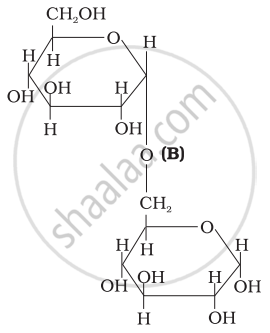Advertisements
Advertisements
प्रश्न
On the basis of which evidences D-glucose was assigned the following structure?
\[\begin{array}{cc}
\ce{CHO}\\
|\phantom{....}\\
\phantom{..}\ce{(CHOH)4}\\
|\phantom{....}\\
\phantom{..}\ce{CH2OH}
\end{array}\]
उत्तर
This structure was assigned on the basis of the following evidences:
1. Molecular formula: The molecular formula of glucose has been found to be \[\ce{C6H12O6}\].
2. Straight chain structure:
(i) When aqueous solution of glucose is treated with sodium amalgam (Na/Hg) or sodium borohydride, it is reduced to sorbitol (or glucitol) a hexahedric alcohol.
\[\begin{array}{cc}
\phantom{.}\ce{CHO}\phantom{.......................}\ce{CH2OH}\phantom{..}\\
\phantom{}|\phantom{...........................}|\phantom{........}\\
\ce{(CHOH)4 + 2[H] ->[Na amalgam] (CHOH)4}\\
\phantom{}|\phantom{...........................}|\phantom{........}\\\
\phantom{..}\ce{CH2OH}\phantom{....................}\ce{\underset{Sorbitol}{CH2OH}\phantom{....}}
\end{array}\]
(ii) Prolonged heating with hydriodic acid and red phosphorus at 100°C gives a mixture of n-hexane and 2-iodohexane.
\[\begin{array}{cc}
\ce{\underset{Glucose}{CH2OH(CHOH)4CHO} ->[Hl][red P, 100°C] \underset{n-hexane}{CH3(CH2)4CH3} + CH3CH(CH2)3CH3}\\
\phantom{............................................}|\\
\phantom{............................................}\ce{\underset{2-Iodohexane}{I}}
\end{array}\]
The formation of n-hexane suggests that all the six carbon atoms in glucose are arranged in a straight chain structure of glucose.
3. Presence of five hydroxyl (-OH) groups: On acetylation with acetic anhydride, glucose gives a pentaacetate. This confirms that glucose contains five –OH groups. We know that the presence of two or more –OH groups on the same carbon atom makes the molecules unstable. Now since glucose is a stable compound, therefore, the five -OH groups must present on different carbon atoms.
4. Presence of one primary alcoholic group: On oxidation with cone, nitric acid, both glucose and gluconic acid give the same dicarboxylic acid, saccharic acid or glucaric acid. The primary alcoholic group \[\ce{(CH2OH)}\] is always present at the end of the carbon chain.
5. Presence of an aldehyde (-CHO) group: Glucose reacts with hydroxylamine, \[\ce{NH2OH}\] to form glucose CHO oxime. Which suggest that glucose contains a carbonyl \[\ce{(CHOH)4}\] (>C = O) groups.
APPEARS IN
संबंधित प्रश्न
Answer the following question.
What is the basic structural difference between glucose and fructose?
Write the reactions involved when D-glucose is treated with the following reagent:
H2N-OH
Oxime is formed by treating glucose with ____________.
Which of the following statements is incorrect regarding glucose?
Glucose reacts with acetic anhydride to form ______.
In the following reaction, identify A and B:
\[\begin{array}{cc}
\ce{C6H12O6 ->[Acetic anhydride] A}\\
\downarrow \text{Conc. nitric acid}\phantom{...}\\
\ce{B}\phantom{.................}\end{array}\]
Three structures are given below in which two glucose units are linked. Which of these linkages between glucose units are between C1 and C4 and which linkages are between C1 and C6?
| (I) |  |
| (II) |  |
| (III) |  |
Write the reactions of D-glucose which can’t be explained by its open-chain structure. How can cyclic structure of glucose explain these reactions?
Glucose with excess of phenyl hydrazine forms ______.
When D-glucose reacts with HI, it forms ______.
